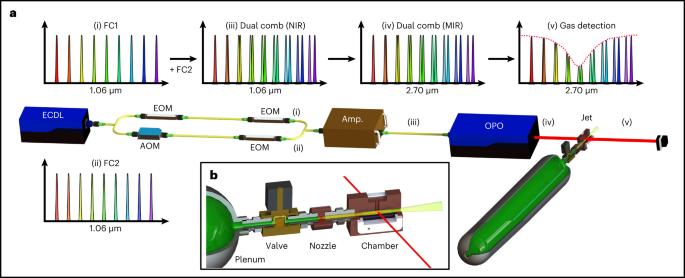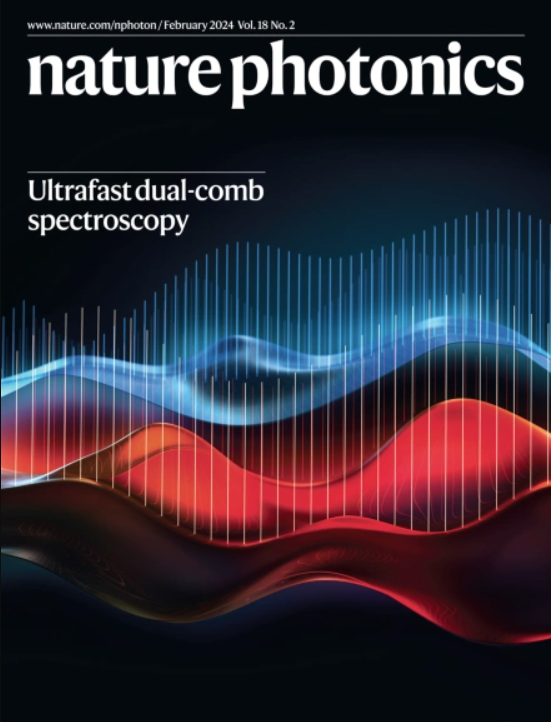Nanosecond time-resolved dual-comb absorption spectroscopy
IF 32.3
1区 物理与天体物理
Q1 OPTICS
引用次数: 0
Abstract
Frequency combs have revolutionized the field of optical spectroscopy, enabling researchers to probe molecular systems with a multitude of accurate and precise optical frequencies. Although there have been tremendous strides in direct frequency comb spectroscopy, these approaches have been unable to record high-resolution spectra on the nanosecond-timescale characteristic of many physiochemical processes. Here we demonstrate a new approach to achieve optical frequency comb generation in which a pair of electro-optic combs is produced in the near-infrared regime and subsequently transferred with high mutual coherence and efficiency into the mid-infrared regime within a single optical parametric oscillator. The high power, mutual coherence and agile repetition rates of these combs, as well as the large mid-infrared absorption of many molecular species, enable fully resolved spectral transitions to be recorded in timescales as short as 20 ns. We have applied this approach to study the rapid dynamics occurring within a supersonic pulsed jet; however, we note that this method is widely applicable to fields such as chemical and quantum physics, atmospheric chemistry, combustion science and biology. A mid-infrared dual-comb system capable of nanosecond time-resolved spectral measurements is realized by using a singly resonant optical parametric oscillator that allows an efficient conversion of an input dual-comb pump at 1 µm into an idler dual comb in the mid-infrared regime.

纳秒时间分辨双梳状吸收光谱学
频率梳彻底改变了光学光谱学领域,使研究人员能够利用多种精确的光学频率探测分子系统。尽管在直接梳状光谱学方面取得了巨大进步,但这些方法仍无法记录许多生化过程所特有的纳秒级高分辨率光谱。在这里,我们展示了一种实现光学频率梳生成的新方法,即在近红外波段产生一对电光梳,然后在单个光参量振荡器内以高相互相干性和高效率转移到中红外波段。这些光束的高功率、相互相干性和敏捷的重复率,以及许多分子物种对中红外的大量吸收,使我们能够在短至 20 毫微秒的时间尺度内记录完全解析的光谱转换。我们将这种方法用于研究超音速脉冲射流内发生的快速动力学;不过,我们注意到这种方法广泛适用于化学和量子物理学、大气化学、燃烧科学和生物学等领域。通过使用单谐振光参量振荡器,实现了能够进行纳秒级时间分辨光谱测量的中红外双梳系统,该振荡器可将 1 µm 的输入双梳泵浦有效地转换为中红外波段的惰极双梳。
本文章由计算机程序翻译,如有差异,请以英文原文为准。
求助全文
约1分钟内获得全文
求助全文
来源期刊

Nature Photonics
物理-光学
CiteScore
54.20
自引率
1.70%
发文量
158
审稿时长
12 months
期刊介绍:
Nature Photonics is a monthly journal dedicated to the scientific study and application of light, known as Photonics. It publishes top-quality, peer-reviewed research across all areas of light generation, manipulation, and detection.
The journal encompasses research into the fundamental properties of light and its interactions with matter, as well as the latest developments in optoelectronic devices and emerging photonics applications. Topics covered include lasers, LEDs, imaging, detectors, optoelectronic devices, quantum optics, biophotonics, optical data storage, spectroscopy, fiber optics, solar energy, displays, terahertz technology, nonlinear optics, plasmonics, nanophotonics, and X-rays.
In addition to research papers and review articles summarizing scientific findings in optoelectronics, Nature Photonics also features News and Views pieces and research highlights. It uniquely includes articles on the business aspects of the industry, such as technology commercialization and market analysis, offering a comprehensive perspective on the field.
 求助内容:
求助内容: 应助结果提醒方式:
应助结果提醒方式:


